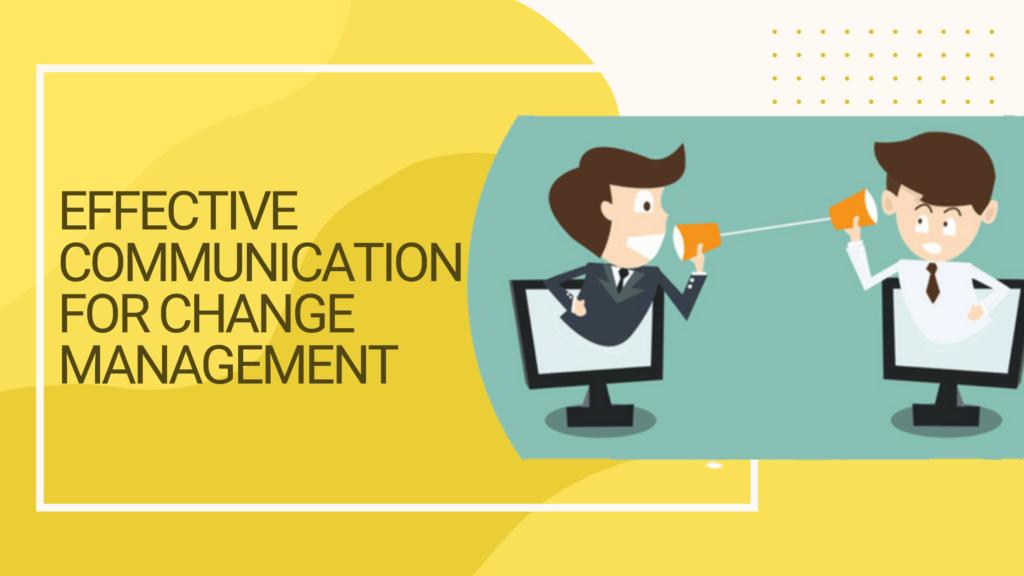Change is constant but hard. Every evolving company needs to embrace changes to adjust to new technologies, ideas, and circumstances. However, implementing changes often proves difficult because people don’t like change.
What happens when employees don’t share the same enthusiasm as you towards an organizational change? In this case, people will resist changes, making implementation difficult. It’s easy to plan changes in the company while forgetting a key aspect of change management, communication! Whether you want workers to learn a new skill or want to introduce new software, communication is key to implementing a successful change program.
What is Change Management Communication
Communication In Change Management describes steps taken to inform and guide employees through a transformation within the organization. It’s a series of strategic efforts, resources, and steps taken to communicate organizational changes and help employees adapt to new changes. In other words, change management communication involves helping stakeholders/employees understand what is changing and it may affect them.
Why is Communication In Change Management Important?
According to Delloite, 60-70% of large-scale change efforts end in failure. Different factors contribute to organizational change failure and most of them can be associated with ineffective communication. A survey by Robert Half showed that 65% of business leaders believe effective communication is key to leading teams through organizational changes.
Statistics like this show the importance of communication to facilitate the successful implementation of a change strategy.
Facilitating a successful change within an organization, especially large companies, can be challenging but it’s possible. If you want to be among the 30% to 40% who implement organizational changes successfully, then it’s best to adopt a change communication plan. Effective communication eases the process of change by helping employees understand what’s going on and promoting a sense of belonging.

When Is Communication In Change Management Needed?
It’s safe to say there’s a need for communication in change management whenever there’s a new strategy, process, initiative, or policy an organization needs to implement. In the absence of communication, people will become resistant to change leading to failed implementation.
Why does Communication In Change Management fail?
The Kübler-Ross Change Curve acknowledges that people going through change experience emotional reactions. Like grief; the emotional reactions to change include shock, anger, bargaining, depression, and acceptance.
One of the reasons change communication management fails is because leaders do not have an effective communication plan to address the emotional reactions to change. If you announce a change, you should be ready to meet resistance, shock, and anger. However, your responses to these reactions will determine whether the change will be successful or not.
Rules For Good Communication During Organizational Change
Organizations can prepare for change by communicating effectively with employees and stakeholders. Here are some golden rules to communicating organizational change.
- Communicate The Vision Early
Sudden change can be so painful and overwhelming. That’s why one of the most important tips for effective change management is by communicating the vision early. Speak about the changes the organization needs by providing details as early as possible.
- Provide the Right Messaging
Organizations need to provide the right messaging to the people that the new change will affect. The right messages will speak about the vision, and the objectives, and help people understand how the change will affect them and the organization. The content of change messages should be clear, concise, and connect with the receiver. Also, the change message should answer the following questions:
- What is the change and when will it take place?
- Where is the change happening? Is it for the whole organization? A branch? A department?
- Who needs to change?
- Communicate the Why
If employees do not understand why change is happening, how do you expect them to accept it?
Communication helps people understand why a company is implementing an organizational change. A good change message should answer why the company needs a change and also answer the WIIFM (what is in it for me) question. What is the benefit of the change to the employees? What’s in it for them? You may have to customize the answer depending on each team or employee.
Also Read: How to team lead through organizational change
- Embrace Two-Way Communication
Communication isn’t complete if only one person is speaking; it needs to flow both ways. Organizations need to embrace two-way communication when implementing change programs. If you are implementing a change without listening to feedback, then you are doing it wrong.
Therefore, encourage feedback, listen to people, and be flexible by adjusting your change program when necessary. Also, create time for the receivers to ask questions, provide input and clarify messages.
- Repeat Change Messages
Another tip for successful change is regular and consistent communication. Ensure you repeat messages of change to facilitate better understanding and acceptance. People may not understand or be resistant to change but repeat messages can ease the process.
- Communicate Through Multiple Channels
Relying on a single method of communication isn’t a good idea for change management in the organization. Therefore, consider communicating change through multiple channels including speaking, video, written emails, social media, bulletin boards, and more. This is important because employees respond differently depending on the method of communication.
Also, it’s best to try and understand the preferred medium of communication for each category of employees. For example, listeners would prefer presentation-styled messages while detail-oriented employees may prefer written documents. Consider the following change management communication channels:
- Email:
Some employees prefer information through emails however it is best not to rely on it only. First, some may skim through the mail without proper understanding. Also, some may miss or ignore emails.
- Workspace Management Tools eg Slack:
A great channel to communicate change is by setting up a forum where you can share messages and details about the change program. This also allows room for employees to engage and ask questions.
- Videos:
If the change program requires some technical steps or explanations, explainer videos would be a great way to help employees learn about the change. Also, most people generally prefer videos to text.
- Presentations/Face-to-Face Meetings
Speaking is one of the most popular ways to communicate change in the organization. With this method, employees can get enough details and give input.
- Communicate Through the Right Messengers
Who is the right messenger for change communication?
The answer to this generally depends on the organization. However, for many organizations, employees prefer to hear about change programs from their direct supervisors. In this case, each department may need someone other than the manager to communicate the change program with them directly. Also, it means supervisors need to have a clear understanding of the change program so they can communicate effectively with their teams. Anyone sending change messages must communicate clearly and in detail.
Generally, the leaders, managers, and supervisors of the organizations should actively communicate change.
- Ensure The Commitment of Leaders
As a leader, you need to be the change you want to see.
One of the reasons change implementation fails is poor commitment not just from the employees but also the leaders. If employees sense that the leaders aren’t committed to a change, they too may become less enthusiastic. All leaders and stakeholders need to understand the importance of the changes and prepare to be ambassadors for the change.
- Evaluate Your Change Communication Campaign
One of the steps people often skip while implementing change is evaluation. It’s important to evaluate whether your change management communication strategies were successful or not. How effective was the communication? Was there a channel that particularly helped? Some of the ways to evaluate include feedback, observations, and surveys.
Now, Prepare A Change Management Plan
Maintaining communication in change management is a great way to navigate change management and it’s best to create a communication plan before rolling out any changes. Your communication plan spells out the steps, strategies and actions needed to implement changes.
A good communication plan should take your employees through the following stages:
Awareness: This involves introducing the change idea to employees by detailing the vision
Understanding: Awareness isn’t enough if there’s no understanding. Communicate the benefits of the change and how it will affect the organization and employees.
Acceptance: This stage involves helping employees see the need for the change and empowering them to see how it benefits them and the company.
Ownership: One of the best ways to sustain change in the organization is by promoting a sense of ownership among the employees. Give room for feedback and give credit to employees when necessary.
Engage the service of change management experts
Good communication in change management reduces the risk of unsuccessful organizational change. Therefore, to foster change efficiently in the organization, it is important to adopt effective change management communication. This will help employees and stakeholders understand what’s changing, why’s is changing, and how it will affect their roles.
Is your organization struggling to effect the right changes? Get in touch with us today, and we will be happy to provide our trusted and tested solutions.

